No products in the cart.
Cow
Cow Hoof Guide To: Anatomy, Problems, Trimming & Caring
Cow farmers make the health of their cattle a top priority. The biggest part of ensuring cattle is healthy, is maintaining the health of the hoof of cows.
Understanding all parts of cow hooves, hoof trimming, and everything in between is critical.
Hoof trimming especially is essential. If farmers fail to do it, the cows are likely to suffer from cow hoof-related problems.
In this article, we will provide you with all the information you need to know about cow hoof anatomy, hoof injuries, hoof problems, as well as hoof-trimming techniques.
*This post may have affiliate links, which means I may receive commissions if you choose to purchase through links I provide (at no extra cost to you). As an Amazon Associate I earn from qualifying purchases. Please read my disclaimer for additional details.
Cow Hoof Anatomy
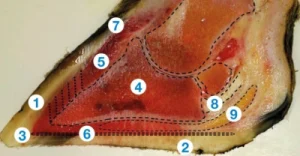
It’s critical to distinguish between the various parts of the hoof, especially while foot trimming.
Below is a detailed description of the nine parts of the hoof which are numbered in the picture above.
- Wall horn: Similar to human fingernails, this part is the strongest and most crucial for weight carrying.
- Sole horn: Equal to the canine or feline footpad.
- White line: Comprised of a weaker horn and the intersection between the sole horn and the wall horn.
- Pedal bone: The major bone of the hoof and similar to that of the end of a human finger.
- Laminar corium: Location of key tissues that support the pedal bone inside the hoof wall.
- Sole corium: Responsible for the formation of a new sole horn, It is vulnerable to injury, resulting in bruising, sole ulcers and white line bleeding.
- Coronary band: Near the hairline at the hoof wall top. From here, a new horn develops towards the toe ending for a year plus 5 months to heal.
- Flexor tendon: Connects with the pedal bone. Toe deformities can occur as a result of deep infection.
- Digital cushion: A thick fat pad beneath the heel, which is critical for absorbing and dissipating force as well as supporting the animal’s pedal bone when it walks.
Read More: Why Do Geese Stand On One Leg in Summer? There are a few reasons – and they’re pretty neat!
Cow Hoof Injury And Problems
Cows can suffer from many problems relating to their hoof, including hoof rot, soft & hard feet, and heel erosions.
Foot Rot (Hoof Rot)
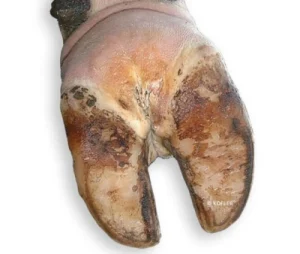
Foot rot, or hoof rot, is a foul-smelling illness of the foot that usually originates between the claws and is primarily caused due to an infection with the Fusiformis Necrophorus bacteria.
Foot Rot causes lameness in cattle, which usually affects only one leg.
The toes stretch and the foot swells over the coronet and the interdigital space develops cracks and fractures. The discharge from these cracks has a distinctly unpleasant odor.
If the infection is not treated, it can spread to the joint space, causing permanent damage.
So, how do you treat cow hoof rot?
Treatment of Foot Rot includes antibiotics and local treatment via parental administration. You should wash the interdigital area and remove loose necrotic tissues.
Antibiotic, sulfa, and antiseptic topical treatments have been used successfully.
A drawing ointment can be helpful if the infected areas are deeper tissues. To avoid the spread of Foot Rot to other cattle, the affected should be removed from the rest of the herd and put in quarantine.
Soft And Hard Feet
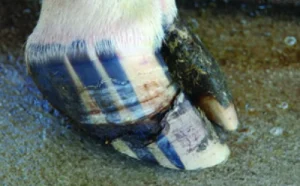
Cracks in the hoof caused by excessively soft or hard feet can lead to infections, abscesses, and sole ulcers.
In free-stall setups, too-soft feet have a higher probability of developing as a result of standing in urine and manure.
Too-hard feet are common in tie-stall barns, particularly those with bedding made from sawdust or kiln-dried shavings.
This can lead to fissures at the feet top, which can extend from the hairline, allowing infections to spread quite high in the feet.
Avoid allowing your cattle to stand in moist soil for long periods if their feet are overly soft, and allow them to stand on a dry surface.
Also, regularly utilize a dry mixture of minerals in walk-through foot boxes.
Do not let your cows stand in a muddy place for long periods if their feet are overly hard. Let them stand, and graze on moist or dewy areas, but neither soft nor muddy. On walkways, do not use barn lime or superphosphate.
Heel Erosions (Under-run Heels)
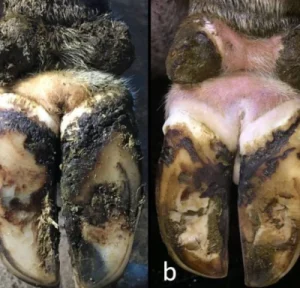
Also known as under-run heels, heel erosions start at the cow heel’s bulb.
They begin as surface pits that may develop into parallel grooves that are eventually filled with black substance and germs.
The grooves in the horn might separate, forming a “flap”. Underneath, new sole forms and materials are packed between the layers.
This is a common occurrence among cattle in wet, muddy lots.
Overgrown hooves cause weight to transfer to their heels, exposing their heels to erosion, particularly in the rear claws.
The aim of treatment should be to remove the damaged horn. After cleaning, you should apply a disinfectant liquid to the exposed area.
Until this area becomes hardened, the cow should be contained for several days.
Read More: What to Do for a Duck with a Broken Leg. Whether one of your ducks is hurt or you found an injured wild duck, here’s a brief guide to starting the healing process.
All About Cow Hoof Trimming
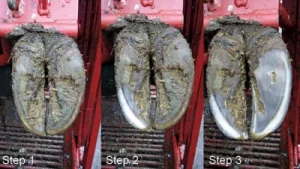
Do Cows Need Their Hooves Trimmed?
Cow hooves need to be clipped since they continue to grow, just like human toenails.
If their hooves are not trimmed and grow excessively long, they change how the cow walks which may result in either temporary or chronic lameness.
However, beef cow hooves do not need to be trimmed regularly or at all in many circumstances. Their short hooves are a result of their genetics and a lifestyle spent wandering through pastures.
Nevertheless, beef cows with genetic abnormalities, including curly toe syndrome and other hoof-related problems, may need their hooves clipped on an annual or biannual basis.
On the other hand, dairy cows require frequent hoof trimming.
They spend lots of time in concrete-floored barns, so it is critical that they feel as comfortable as they can. Dairy cattle with excessive hoof growth will produce less milk and have poorer overall health.
Most dairy farmers prepare a regular hoof clipping plan in place to maintain their cows’ productivity and health.
Does Trimming A Cow’s Hoof Hurt?
If the correct portion of the cow hoof is removed (without cutting into their sensitive quick) and their hooves are each balanced appropriately for easy walking, trimming should not be hurtful to the cow.
Even though is it not painful, trimming will not be their favorite procedure.
How To Trim Cow Hooves?
There are 5 steps in the Dutch trimming method.
Step 1: Trim the inner claw
For ordinary Holstein cows and bulls, the optimal length of their toes is 3.14 inches. Remember to never trim any toe shorter than this.
Trim any extra sole in a cow’s toe area to 0.25-inch thickness. A white-lined ring will appear inside its sole once it has been trimmed to the right thickness.
Step 2: Trim the outer claw
With the same techniques as step 1, trim the cow’s outer claw on its same foot. After being trimmed, the outer and inner claws should be the same length.
To promote even weight distribution throughout the entire foot, the sole of both the outer and inner claws should be the same height.
Crucial tip: While trimming the cow’s front feet, use the same techniques as for back feet, but begin by clipping its front feet outer claws first.
Step 3: Modeling the soles
It’s time to model the soles. If done properly, it will relieve the pressure on the most prevalent places for sole ulcers and prevents manure build-up between the claws.
Crucial tip: Remember to safeguard the cow’s toe triangle. Avoid cutting in the white line located inside of the cow’s toe while modeling its claws.
Step 4: Identify lesions
Identify and therapeutically trim any lesions. Inspect the cow’s sole for any hemorrhages or abscesses. Locate uncomfortable claw areas with a hoof tester.
Also, look for signs that indicate infectious claw lesions on the flesh between the cow’s toes or on its heels.
Step 5: Remove necrotic tissues
Trim any loose horn on the cow’s heels and any visible ridges and remove all necrotic tissues.
When To Trim A Cow’s Hoof?
Hoof trimming should be done bi-annually in most cases.
Nevertheless, infectious diseases may raise the requirement for hoof trimming because this activity can assist relieve some pain linked with these diseases.
How Much Does It Cost To Trim Cow Hooves?
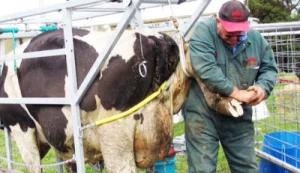
The cost of cow hoof trimming done by a professional depends on the location and is often less expensive than you might think.
Professional hoof trimmers might demand a mileage fee for their journey and large distances, but they typically charge from $10 to $25 per cow.
Cattle that require substantial cutting and correction, as well as wrapping, will be more expensive.
Vets may charge you more, especially if the cows’ hooves are being treated for medical reasons.
To drive total trimming expenses down as much as possible, many dairy producers, particularly large-scale operations, will purchase cow hoof trimming tools and train their personnel to do the job themselves.
Cow Hoof Care: Tips For Prevention
Lameness is typically a multifaceted issue. In other words, there are several factors on the farm that can result in bovine lameness. We will mention some tips below to prevent this problem.
Provide Enough Nutrition
Nutrition such as carbohydrates, trace minerals, vitamins, and protein can aid in the prevention of foot issues.
It is not always sufficient to create the perfect diet for good cows’ hoof health alone.
When it comes to preventing lameness from becoming a herd concern, nutrition should be considered alongside other measures.
Good Feeding Management
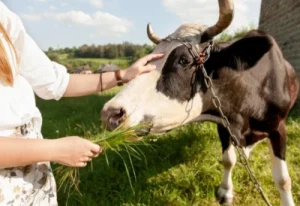
Feeding frequency, the particle size of both forages and grains, diet transitions, as well as first-calf heifers going into your milking herd are factors that have the greatest impact on the cows’ feet.
Supply grain to your dairy cows at least twice per day if they are conventionally fed.
The frequency increases to 3 or 4 times a day with cows producing more than 80 pounds of milk. Before giving grain, provide some forage and/or hay.
Daily exercise
Exercise is essential for maintaining healthy tissues and boosting blood flow to the cows’ feet.
Sluggish blood flow, swelling, and edema can be attributed to not doing enough exercise.
Likewise, too much exercise and concussion on concrete surfaces can result in trauma and mechanical damage as well as a higher likelihood of sole ulceration.
Comfortable Stall
Ample stalls should be built to allow the cows to recline and ruminate between 10 and 14 hours a day.
The dimensions of the stall must be appropriate for the contained cows’ size.
Large cows require a stall length varying between 7 and 8 feet. Depending on the size of the cattle, the width ranges between 42 and 50 inches.
It is crucial to have soft bedding. Sand is the best bedding for cows since it provides them with both comfort and traction.
Furthermore, the sand must be clear of small stones that could pierce the sole horn.
Especially in the summer, you need to install the best barn fans to have good ventilation for your stall.
FAQs about Cow Hooves
1. Can you eat cow hoof?
Simmering cows’ hooves generates gelatin, which has a colloidal component that draws digestive fluids, preventing gastrointestinal bacteria from sticking to colon walls.
Digestion and absorption are aided in this manner, and the likelihood of stomach congestion is minimized.
Cows’ hooves are the finest choice for minerals like calcium, phosphorus, silicon, magnesium, sulfur, and trace elements because these minerals are present in a form easily absorbed by the human body.
2. Do cows feel pain in their hooves?
Seriously splitting hooves can be excruciatingly painful and take a long time to heal. Hence, cracks in cow hooves should be addressed right away. Every six months, follow their instructions for upkeep.
3. Will a cow’s hoof grow back?
A cow’s hoof grows continuously, about 2.5 inches per year. Therefore, it should be trimmed at least twice per year.
4. Why do horses need shoes but not cows?
The simple answer is that cows do not need shoes like horses do because they are not expected to do as much as horses do and are not walking on a wide variety of surfaces.
Final words
Cow hoof problems can be a thorny issue for both the cattle and the cow farmers.
However, with the help of our article, you can take good care of your cows’ hooves and prevent any related health problems.
If there is any concern, please let us know in the comment box below.
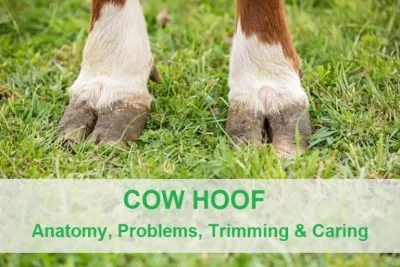

Hi there, I am a veterinary student currently doing a comparative anatomy project on animal hooves. May I use the image of the internal hoof anatomy that you have on this page (as long as credit is given, of course)?
yes, of course, you’re welcome.